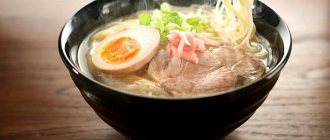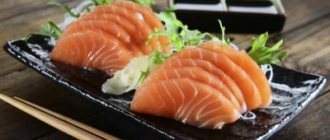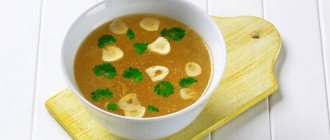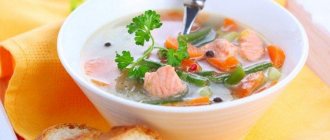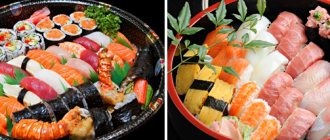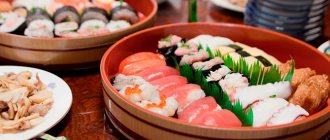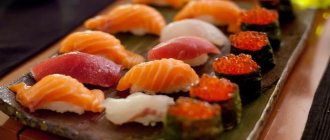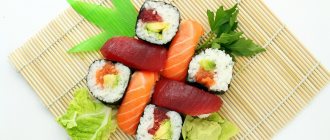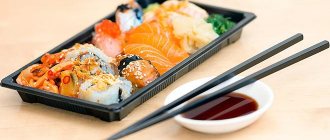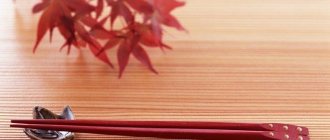East Asian cuisine is increasingly attracting Russians, and there are plenty of reasons for this. The most important thing is that the dishes are easy to prepare, but they turn out incredibly tasty and unusual. Japanese restaurants often serve soups, but they are radically different from domestic ones. If in Russia they prepare rich and thick stews, then the Japanese make light and dietary soups. As a rule, they complement main dishes. Suimono soup sounds interesting, but what is it? In order to cook it, you will have to study several features of Japanese cuisine.
Suimono broth - what is it?
In Japanese cuisine there are 2 types of broths - thick or light transparent. The former are more reminiscent of stews, as they contain vegetables, meat, fish or legumes, which add thickness. For the second type, only water and fish are used, supplemented with Chinese radish, sauce or seaweed.
Suimono is distinguished by its ideal transparency; in fact, the broth is a dressing. Chicken or fish fillet, boiled eggs, mushrooms, seaweed, onions or other vegetables are placed on a plate, and suimono is poured on top. The dish is seasoned with spices and eaten; if desired, you can use almost any ingredients, adapting the step-by-step recipe to your own taste.
Similar chapters from other books:
Seafood
From seafood Sea kale, so tasty... Sea kale is a healing, health-improving food product that removes radioactive substances and other toxic compounds from the body. Therefore, you need to eat 2 tsp daily. this product in any form -
Seafood soup
Seafood soup 1 package of seafood cocktail, 1 carrot, 1 large onion, 1 stalk of celery, cauliflower Open the package of seafood, pour oil into a frying pan. Stew carrots in it, cut into slices, cut into slices
Seafood cocktail
Seafood cocktail 500 g frozen seafood cocktail, 2 onions, 1-2 cloves of garlic, 50 ml vegetable oil, 1 tbsp. l. balsamic or wine vinegar, 1 tbsp. l. table vinegar, 1 tbsp. l. sugar, salt, pepper to taste Cut the garlic crosswise
Seafood appetizers
Seafood appetizers Appetizer of squid and apples Ingredients: 200 g squid, 200 g sour apples, 5 hard-boiled eggs, 1 onion, 100 g mayonnaise, 1 bunch of dill, salt to taste. Rinse the squid, boil in salted water, peel and cut in small pieces. Peel the onion
Seafood Sandwiches
Seafood sandwiches Sandwich “Merry Holland” Cut a loaf of rye bread made from premium flour lengthwise into pieces 1.3-1.7 cm thick. Place the filling on the pieces in the following order: place the salted herring on the right side, and “Invigorating” salad on top. , on
Seafood soup with cheese
105. Seafood soup with cheese products 200 g canned squid and shrimp, 150 g cheese, 2 carrots, 1 liter of water, salt, Cooking time - 20 minutes. Wash the carrots, peel and cut into slices. Cut the cheese into cubes. Pour 1 liter of water into the multicooker bowl, add carrots.
Carrot puree soup (ninjin no suimono) (Japanese cuisine)
Carrot puree soup (ninjin no suimono) (Japanese cuisine) Heat the oil in a deep frying pan, fry the onion until golden brown, add the carrots and cook for 1 minute. Pour in the broth, bring to a boil, reduce the heat, cover with a lid and cook until tender.
Peking seafood soup
Peking-style seafood soup Ingredients: 200 g mussels, 200 g shrimp (peeled), 1 onion, 10 olives (pitted), 150 g Chinese cabbage, 1 bunch of parsley, salt. Method of preparation: Peel the onion, wash. Wash the parsley and chop it. Wash the Chinese cabbage, finely
Seafood soup with cheese
Seafood soup with cheese Ingredients: 200 g squid (canned) and shrimp (peeled), 150 g cheese (any), 2 carrots, salt. Method of preparation: Wash the carrots, peel them, cut into slices. Cut the cheese into cubes. Pour 1 liter of water into the bowl, add carrots, cook
Recipe 1: suimono with seafood delicacies
This is typically the version served in most Japanese restaurants, so it's a good place to start. The decoction is prepared using daikon, tuna chips, Hondashi powder and seaweed. Seafood is used as filling. Soup ingredients:
- fresh daikon - 150 g;
- water - 1 liter;
- small octopuses - 300 g;
- kombu and wakame seaweed - 20 g each;
- tuna chips - 25 g;
- Japanese noodles - 50 g;
- dried shiitake mushrooms - 20 g;
- Hondashi fish broth mixture - 1 tbsp. l.;
- rice wine - 10 ml;
- fresh green onions - to taste;
- soy sauce - a few spoons.
Peel the daikon, cut first into slices, then into cubes. Throw the root vegetable into boiling water for 10 minutes, then strain the broth. Immediately dissolve the broth mixture in it, add kombu seaweed and shavings. Cover the pan with a lid and leave for 20 minutes to allow the liquid to infuse. After 20 minutes, strain the broth, but do not discard the seaweed and tuna flakes. They are quite suitable for reuse, in which case it is recommended to infuse them for about 30-40 minutes.
Wash seafood (octopus) and place them in boiling water for 2-3 minutes. Add dried mushrooms and noodles to the broth and cook for a couple more minutes. All that remains is to add rice wine, soy sauce, bring to a boil and turn off the heat.
Denis Borisov
Assistant chef of the restaurant "Fisherman's House"
Ask a Question
You can’t cook for a long time, otherwise the octopus will be tough, and the noodles, on the contrary, will be too soft! Place wakame seaweed in a bowl and pour suimono soup over it.
Features of Japanese cuisine
Japanese food is not just food for the body, but a delight for the eyes. Cuisine of the Land of the Rising Sun:
- requires a reverent attitude to form and color;
- includes the concept of seasonality and appropriateness to weather and period of year;
- puts the natural taste and appearance of ingredients at the center;
- served in small portions and small pieces that can be eaten with chopsticks or hands;
- necessarily includes green tea accompanying the main meal.
Traditional dishes are prepared from fresh ingredients, avoiding food that has been stored for a long time (with the exception of sauces and rice). Many recipes include seafood.
An important feature of Far Eastern cuisine is the association of food and season. Each season corresponds to a set of delicacies. Taking this association into account is just as important as using only fresh produce. For example, in autumn, carrots are cut into the shape of maple leaves for soup, and spring desserts are decorated with sakura flowers.
Japanese dishes cannot be called heavy. Food is served in small portions. Most traditional foods are low-calorie. However, there is no threat of hunger: a wide variety of dishes and snacks are served at the table at the same time, so everyone will leave full. In former times, an aristocratic meal included up to 20 courses, and the classic division into hot, cold, soup, main course, and dessert was not used. The Japanese distinguish the beginning, middle and end of a meal. The order of consumption is at the discretion of the diner.
Japanese food is tasty and dietary
Recipe 2: the lightest broth
An excellent option for beginners who are just getting acquainted with Japanese cuisine. You should not use many products included in a traditional recipe at once. Firstly, it is not always possible to do everything correctly the first time, and secondly, you may not like the taste of homemade soup. Ingredients of this dish:
- dried seaweed - 150 g;
- water - 1 liter;
- one small lime;
- lower part of leek - 100 g;
- sake - 5 ml;
- soy sauce.
Japanese dishes are often not salted at all - they contain soy sauce. It can be added either while preparing the broth or directly to the plate.
For 1-1.5 hours, pour water over the seaweed so that it swells. When it has increased in size, put the pan with the same water and cabbage on the fire and cook for 7 minutes. Then cool the liquid and strain through cheesecloth. Wash the leeks, finely chop them and add to the broth. Cut the lime into small slices and place in a saucepan.
Bring the broth to a boil, then add soy sauce and sake, cook for another 5 minutes. Strain the resulting liquid and use as a separate dish or soup base. It goes well with fried chicken fillet, stewed mushrooms and onions.
Find out the secret of delicious soup
Secret 1
Adding eggshells will create a clear broth. Before adding vegetables, it must be strained.
Secret 2
Over-salted soup can be easily saved with sugar. Place a piece of refined sugar on a spoon and lower it into the broth until the sugar begins to melt.
Secret 3
Boiled greens look ugly and have no value, so add parsley, dill or basil before serving.
Secret 4
For thickness, it is often recommended to use flour, but it should first be fried in a dry frying pan, otherwise lumps will form.
Cooking features
The process of preparing suimono broth is not very complicated, but Japanese cuisine is not so familiar to our compatriots that we can leave the technology for cooking clear Japanese soup without additional explanation.
- If you want to cook suimono soup at home that is identical to the original, you will have to spend time and money collecting the appropriate ingredients. If you're lucky, you'll find everything you need to make suimono broth in the hypermarket on the shelves where sushi products are located. You can purchase seafood delicacies in another section of the store.
- The recipe for suimono broth can be adapted to the realities of Russian life by cooking it from seaweed alone or even from daikon. Another option is to use any fish broth as a base instead of dashi. The set of fish delicacies indicated in the recipe can also be adjusted taking into account the products that you have in the refrigerator.
- Suimono soup can be cooked not only with seafood, but also with mushrooms, if the combination of fish broth and mushrooms does not seem scary to you. When choosing a mushroom addition, the liquid base can be made without adding fish, from just seaweed or daikon.
Suimono soup is served in small clay cups, shaped like bowls. After all, this broth can not only be eaten, but also drunk.
Recipe 3: red fish suimono
Suimono soup with the addition of salmon (salmon, pink salmon, chum salmon, pink salmon, trout) will be more satisfying. It's still low in calories but still nutritious. Cooking time is no more than 25-30 minutes. List of ingredients:
- dashi broth - 600 ml;
- red fish fillet - 600 g;
- leek - 1 pc.;
- lime - 1 pc.;
- light soy sauce - 30 ml;
- sake - 10 ml.
This recipe with photo is somewhat reminiscent of the previous one, although there are still some differences. First you need to wash and cut the fish into small cubes. Cut the lime and leek into slices. Bring the dashi broth to a boil, pour in soy sauce and sake. Next, send the prepared salmon - cook over medium heat for 4-5 minutes.
Take out the fish pieces and place them in bowls. Pour the prepared broth over the fish, top with lime and leeks. If necessary, you can add more soy sauce if the soup is not salty enough.
Rules for serving Suimon soup
Like all Japanese soups, suimona is served in a deep ceramic tureen bowl and with a plate stand of the same material. Traditionally, all liquid dishes have a small portion. The bowls resemble a cup in size and a pot in appearance. The dish in the bowl is prepared as follows:
- Place the ingredients in the bowl (shrimp, carrots, seaweed).
- The broth is filtered and, if necessary, heated or cooled to 70-75 o C.
- Broth is poured into a plate with vegetables and seafood.
- The dish is decorated with herbs and lime.
The chefs of the Akira restaurant adhere to these rules, so the treats are served to guests warm and not hot. This soup is ready to eat; it does not need to be cooled.
Unlike soups common in Russian cuisine, Japanese liquid dishes are served after the main meal (sushi, rolls, hosomaki, tempura) or simultaneously with it. Suimona is more suitable for sushi, so it never contains tofu cheese. For residents of Asian countries, this type of meal is something like a drink or broth to wash down. That is why they are 80% liquid. For comparison, traditional Russian first courses are only 30-40% liquid.
Calorie table
| Dish | Serving Size | KBZHU |
| Suimono (broth only) | 100 g | Calories - 27 kcal, proteins - 1 g, fats - 1 g, carbohydrates - 1 g |
| Seafood soup with broth | 100 g | Calories - 76 kcal, proteins - 3.6 g, fats - 1.2 g, carbohydrates - 9.2 g |
| Salmon soup | 100 g | Calories - 96 kcal, proteins - 4.1 g, fats - 1.4 g, carbohydrates - 16.8 g |
Yakitoria, Zodiac, Cherry Blossom - these and other Japanese restaurants delight visitors with many delicious dishes. Suimono shiro soup whose recipe is simple, absolutely anyone can prepare it. You just need to choose the appropriate recipe and buy the right products.
Soybeans
Although soy is not considered a traditional Japanese ingredient, it has long taken the country by storm. Distribution began from Kyushu, Honshu in the 18th-19th centuries. The product was brought from Korea and they learned how to prepare all kinds of dishes from it. The sauce and cottage cheese (tofu) have gained particular popularity. There is soy cheese that tastes like Philadelphia, and even soy sushi.
Miso paste is made from soybeans - a fermented product, on the basis of which the broth of the same name is made.
A popular soy product is fuju, the cooled, dried foam skimmed from boiling soy milk. Fuchsia is sometimes called soy asparagus.
Miso paste
